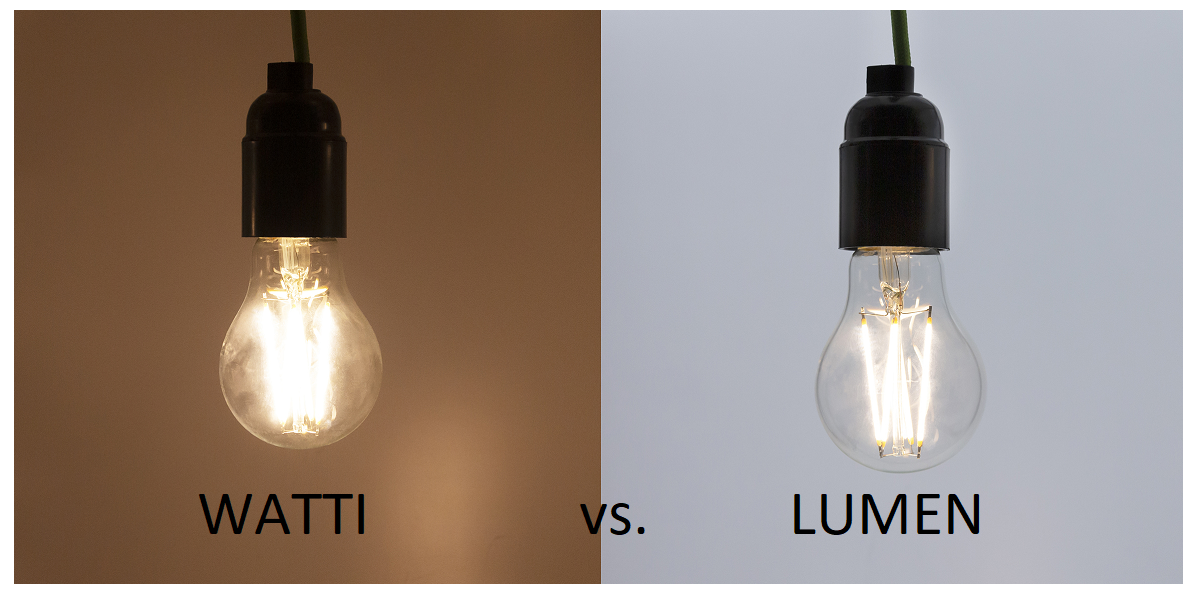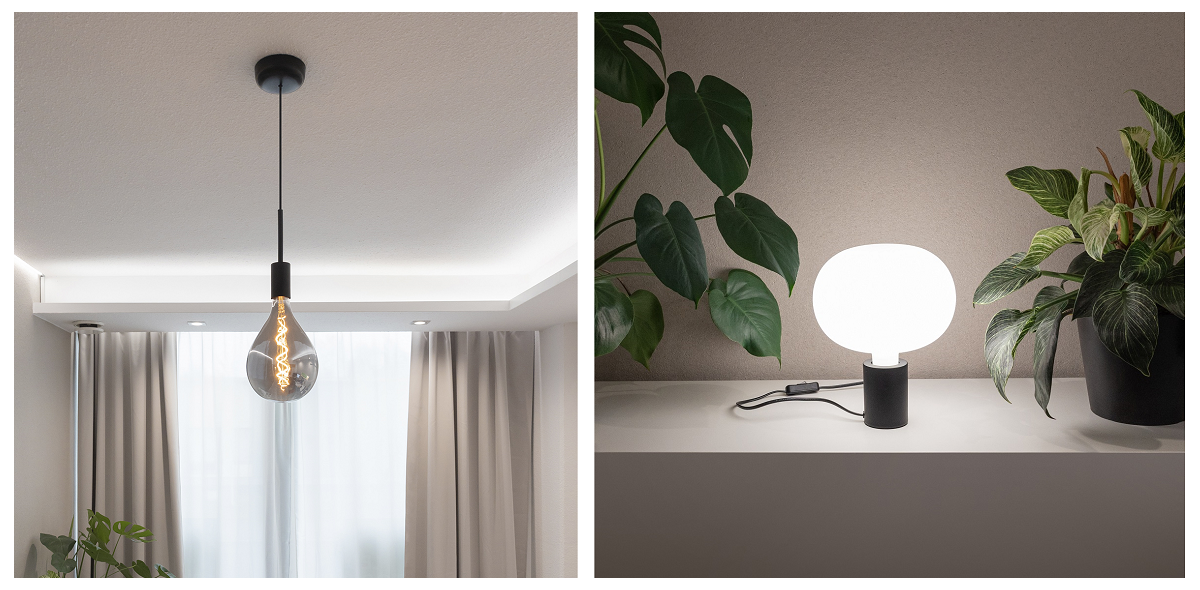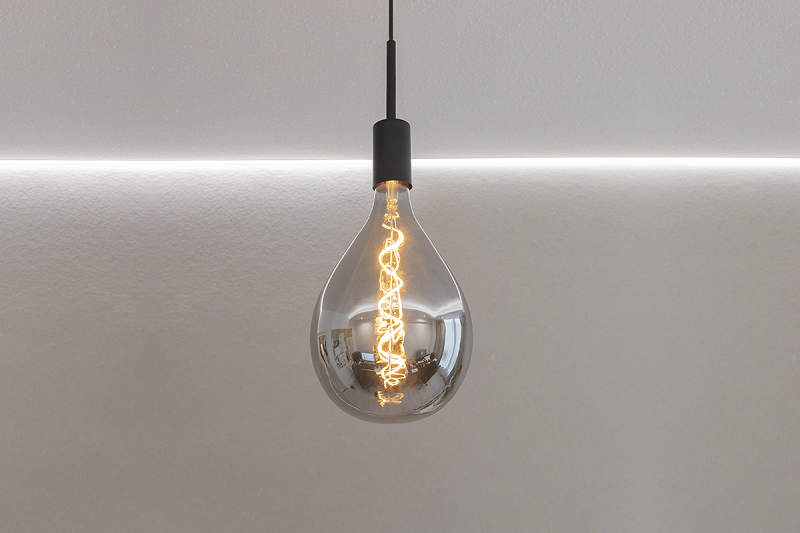Summarize
- Lumen measures the amount of light produced by a light source
- Watt measures the energy consumed by a light source to produce light
- LED lamps are more energy efficient than traditional incandescent lamps
- Luminous efficacy is how efficiently electricity is converted into light
- Different rooms require different amounts of lumen for lighting
Lumen and Watt, how do they differ and what do they have in common?
What is Lumen?
Lumen is the best indicator of a light fixture’s total light output.What is a watt?
A watt is a unit of power from which the energy consumption of a light source can be determined, in kWh.Lumens versus watts

Lumen and watt, their relationship
Lumens to watts conversion
new energy label for LED lightsDifferent lighting technologies and energy efficiency
| VALUES | INCANDESCENT BULB | HALOGEN | FLUORECENT TUBE | LED |
|---|---|---|---|---|
| Consumption | 100 W | 70 W | 20 W | 12 W |
| Efficiency | 16 lm/W | 22 lm/W | 80 lm/W | 130 lm/W |
| Lifetime (hours) | 1 000 h | 2 500 h | 10 000 h | 50 000 h |
| Price | Cheap | Cheap | Medium price | Expensive |
| Running costs | Very expensive | Expensive | Mid-priced | Cheap |
Lumen and Watt, conversion
Explanation of luminous efficacy
Led can’t take the heat
Lumen and wattage recommendation for different rooms
the Finnish Federation of the Visually ImpairedKitchen
Living room
Dining room
The dinner table is a quiet place for the family to relax, and often a warmer light light is all that’s needed, providing 300-400 litres of light on the table. Nowadays, of course, the situation has changed because people work remotely in their homes a lot. Then a variable amount of light is in place.Bedroom
Office
Bathroom
Discover the technical features
Energy labelling
New energy label for LED lightsColour rendering index
Colour temperature
Other technical reading
What makes LED fixtures expensive?What is the difference between CRI and RA?What is good make-up lighting?Led lighting expert
Read more here or order a lighting designcustom-made LED stripsinstalledDid you know? LedStore offers affordable lighting design for your entire home! (myynti@ledstore.fi)Did you know that we already have over 3 500 pictures of our LED installations in our Gallery!Photo gallery of Led lights:
Product gallery: Pictures of PRODUCTS in different installation locationsIndirect light: Indirect light in different spacesRoom-specific: Light in different roomsReferences: Complete houses that have been photographedFAQ
1. What is the difference between lumen and watts?
A lumen (lm) measures the amount of light produced by a light source, or luminous flux, while a watt (W) measures energy consumption, or electrical power. Traditionally, higher wattage meant brighter light, but with LED technology this relationship is no longer so straightforward.
2. Why are lumens more important than watts when choosing lighting?
Lumens give a direct indication of the amount of light produced by a light source, which helps to assess the brightness of the lighting. Wattage, on the other hand, indicates energy consumption, but not necessarily lighting efficiency, especially between different types of light sources.
3. How many lumens are needed in different rooms?
The amount of lumen required depends on the use of the room:
- Kitchen: 400-500 lm/m²
- Bathroom: 600-800 lm/m²
4. How does the energy efficiency of LED lights compare to traditional light bulbs?
LED lights are significantly more energy efficient than incandescent bulbs. For example, a 100 W incandescent bulb produces around 1 600 lumens, while an LED with the same amount of light consumes only around 14 W, which means energy savings of more than 80%.
5. Why does the wattage no longer tell you how bright the light is?
The energy efficiency of different light sources, such as incandescent and LED lights, varies greatly. The same wattage can produce different amounts of light depending on the lighting technology, so the wattage alone is no longer an indication of the brightness of the light.
6. Are lumen and wattage related?
There is no direct relationship between lumens and watts in LEDs. The lumen indicates the amount of luminous flux, and the watt indicates the energy consumption. Both values are important for fixtures and bulbs and can be used to determine luminous efficacy.
7. How many lumens are in 1 watt?
A standard 60 W incandescent bulb can produce a luminous flux of around 750 lumens. Thus, we can say that 1 watt = 12.5 lumens. This number of lumens is obtained by dividing 750 lumens by 60 watts. If we consider a 6 watt LED with a light output of 500 lumens, then 1 watt will give 83.3 lumens.
8. Is 800 lumens too much?
First you need to know what that 800 lumens will be used for. In a dining room, a single lamp with a light output of 800 lumens can be considered good, as people appreciate good light when working remotely. But in the bedroom, the same amount of light is already too much if it is evenly distributed throughout the room. It must be remembered that the lumens in one lamp are spread out into the environment and the final number of lumens depends on the need and the square footage of the space to be illuminated.
9. How large an area does 1 000 lumens illuminate?
A 1000-lumen omnidirectional light source effectively illuminates a 2 to 3 meter area to a basic lighting level. 1,000 lumens will give you the light you need for a worktop, for example, but it’s still too much for a quiet meal. On the other hand, outdoors, a light producing 1000 lumens can be visible from over 100 meters away.
10. Are different amounts of lumen necessary in different rooms?
Every room in a house is different, and the need for light varies depending on how the space is used. In homes, lighting plays a key role in creating atmosphere, in addition to being essential for safety and task performance. It’s a good idea to follow recommended light levels to ensure that energy consumption is directed where light is truly needed, avoiding unnecessary scattered light.Welcome to Lamppukauppa LedStore’s showroom to explore lighting possibilities and design the perfect solution for your space. We serve a wide range of customers—consumers, resellers, and businesses alike.
You’ll find us at Mesikukantie 16, 01300 Vantaa (Koivuhaka).
Feel free to contact us by phone at +358 45 251 4510 or by email at myynti@ledstore.fi.


